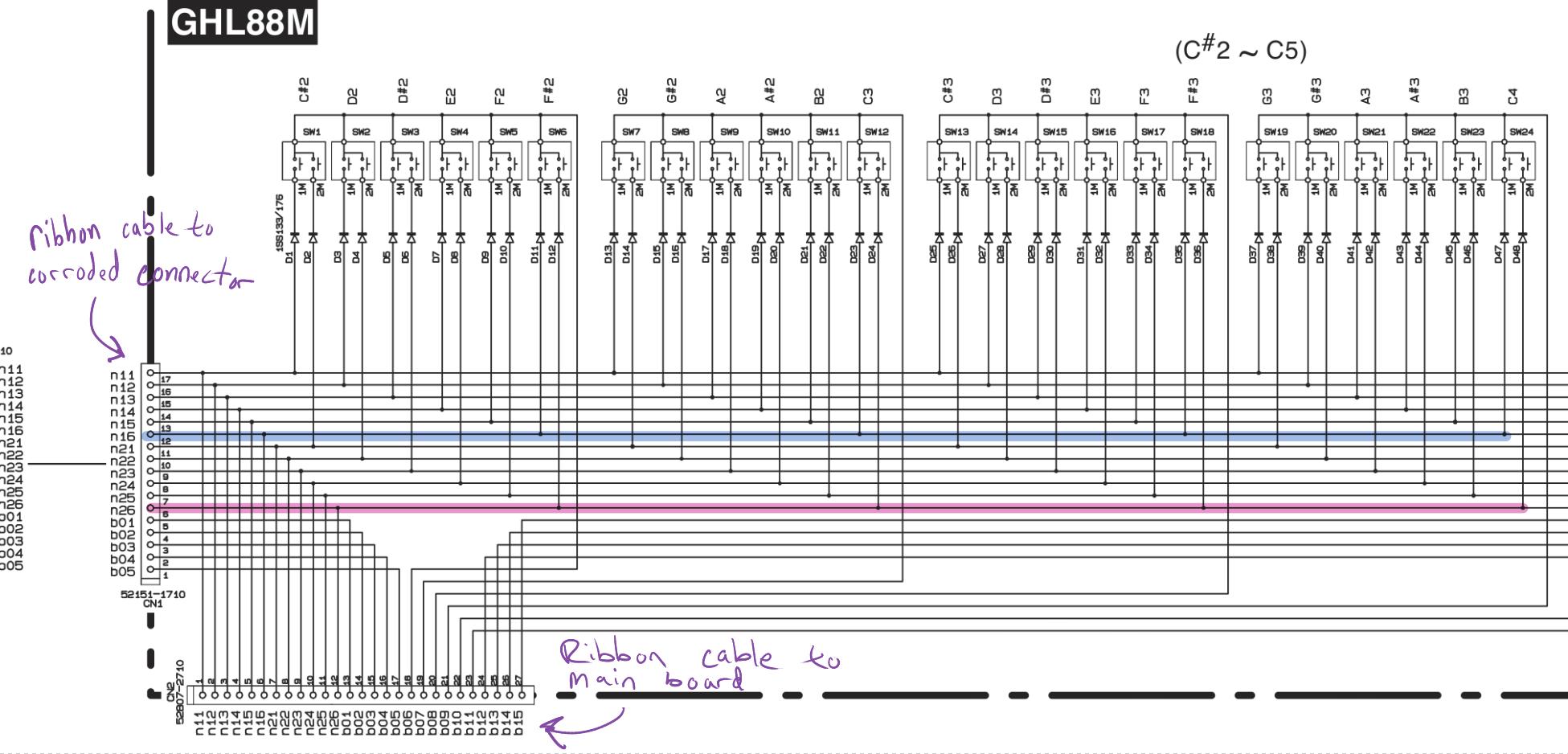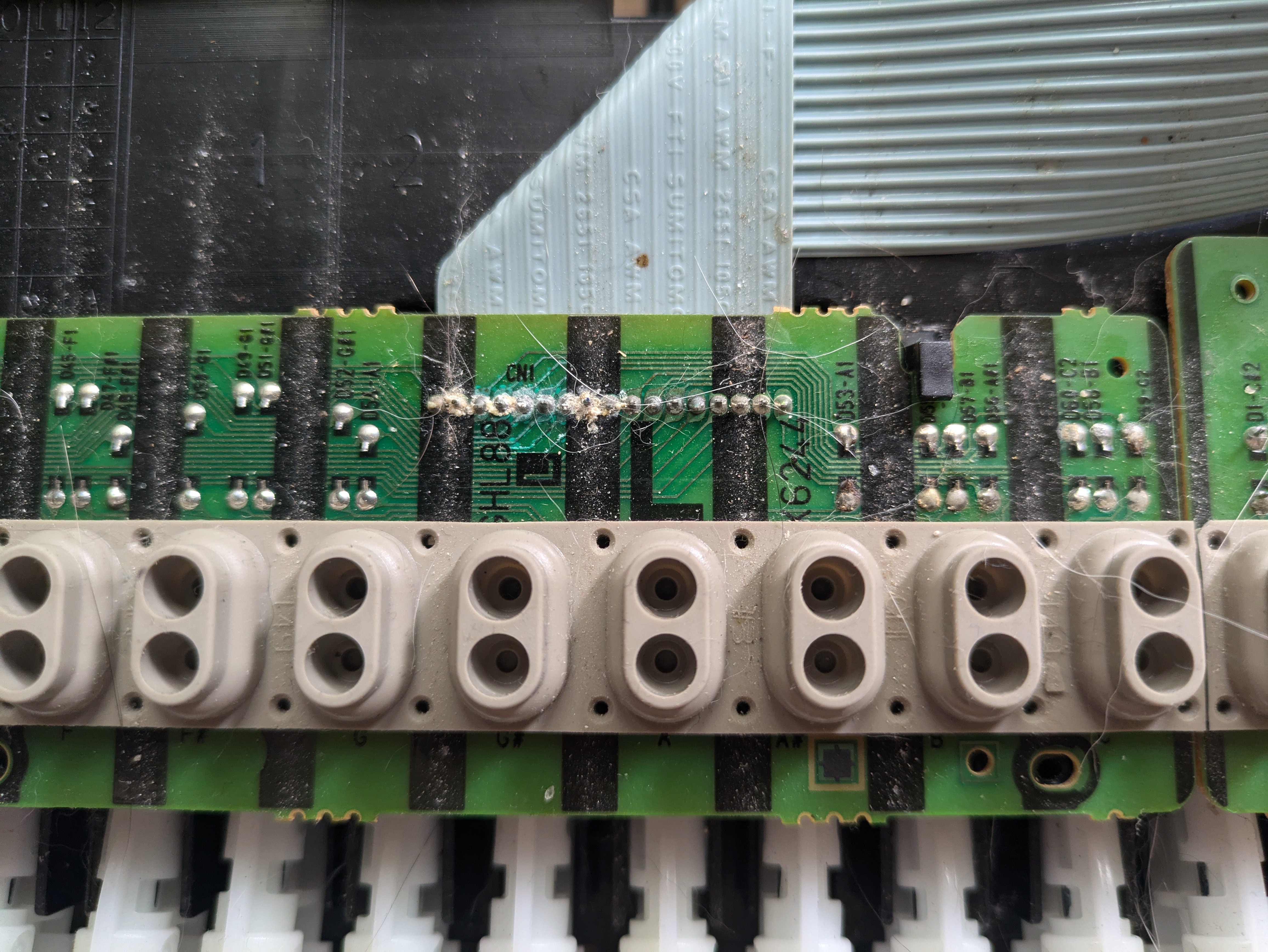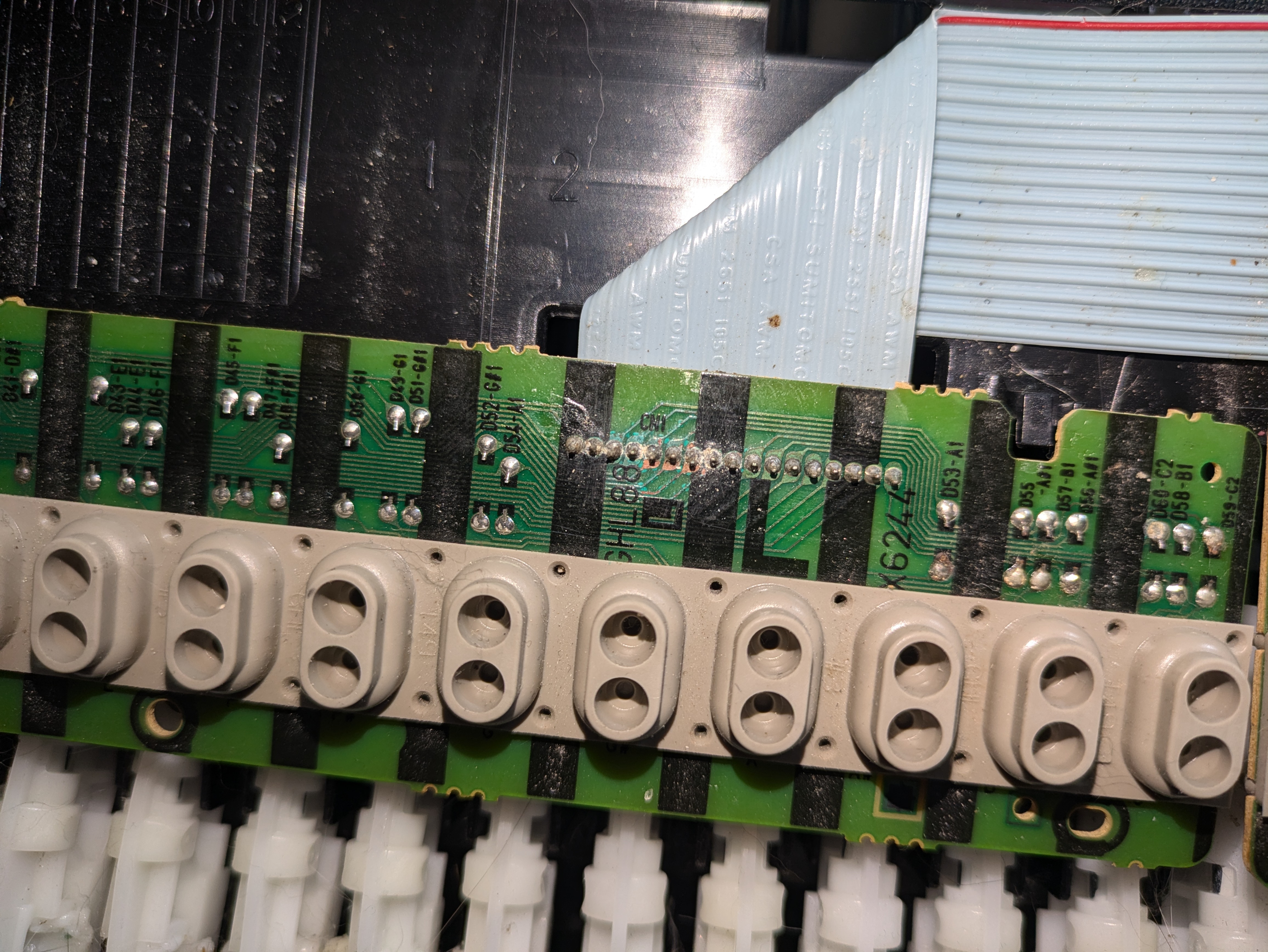Overview
I recently had a problem with my Yamaha DGX-650 piano keyboard. I solved it by taking a wire brush to some corrosion I found. Thanks for reading! Like and subscribe.
Despite it being a simple fix, in trying to do some research before tearing the keyboard apart I was surprised at how little information I found about this keyboard and problems people have had with it. When I did find people reporting similar issues, they didn’t provide enough information to confirm whether I had the same problem and no one ever shared that they’d actually fixed the problem. Because the fix was so simple, and simple enough to understand, I figured I’d write down what I could so that people can make their instruments last just a bit longer.
Around a year ago it began occasionally missing notes. Two notes would sound from a single keypress, or keys wouldn’t sound in certain combinations. It was hard to track down what keys were affected and what the behavior was, so after a few months of again avoiding practicing I dismantled the keyboard to clean the keyswitch contacts. This did nothing to solve the problem and took a fair amount of effort, so the piano sat unplayed through two moves.
Even in a compulsive saver such as myself, unpacking a piano that was last played two houses ago prompts some garbage cleanup. I needed to replicate the problem and make an earnest attempt to fix it, or else it was going out to the curb.
After about an hour of noodling, I was able to consistently replicate at least one of the problems:
The Problem
The clearest, most easily replicable issue was with F#3, B3, and C4.
Playing and holding those keys in that order leads to C4 not sounding. Playing them in reverse order seems to behave normally at first, but if you release C4 while holding B3, C4 continues ringing out. F# and C together behave, F# and B behave, and B and C behave - but the three together don’t. There are similar problems across octaves, though each octave behaved a little differently. An octave up, the C would sound but always at max velocity.
The Speculation
The behavior affecting the same keys, but in multiple octaves, points to the key detection / polling circuit. Basically, for the computer in the keyboard to make sounds corresponding to the pressed keys, it has to constantly check which keys are pressed.
Generally, when audio electronics age and start behaving incorrectly, I suspect capacitors. Looking at the service manual reveals that there are indeed capacitors for each key (meaning, one that is shared across all C#s). These capacitors are low-capacitance ceramic capacitors, so while those are unlikely to fail, they were what I was going to check first.
How Key Polling Works
Short answer: I’m not totally sure. Longer answer:

- The main board monitors, via the ribbon cable that connects the main board to the keys, lines n11-n26 and b01-b15.
- There are unique combinations of N and B signal wires for each key. Each key will share N wires across multiple octaves (so, each C# on the keyboard uses n11 and n21), but different C#s use different B wires. These are grouped such that there are two per octave, with C#2-F#2 sharing b06, G2-C3 sharing b07, and so on.
- I don’t know for sure which lines were being bridged by corrosion, but because of the keys affected and the fact that the problem disappeared with the leftmost board disconnected, it had to have been wires on that connector. The only lines shared across all three boards are the N lines, so the B lines are out as the sole cause - I suspect that either n15 and n16 were bridged, or n25 and n26 were bridged.
The Repair

I never quite got as far as testing the capacitors. Pictured here is what I saw when I opened the keyboard: the connector for the lower of the three keyswitch circuit boards (GHL88L, GHL88M, and GHL88R for left, middle, and right) was corroded enough that some of the pins likely had continuity. This connector was for a ribbon cable that carried the shared lines across all three boards, so bridged connections here could cause exactly the symptoms I saw - unusual key detection for the same keys in different octaves.
To confirm the issue, I disconnected the ribbon cable bridging GHL88L and GHL88M. The problem with F#3, B3, and C4, went away entirely, more or less confirming it was either the corrosion or the leftmost keyswitch board.
I scrubbed at the corrosion with a brass wire brush and lightly scraped between each solder joint with a knife to be absolutely sure that there would be no continuity between each line.

A quick test, and success! All it needed was scraping away that corrosion.
Observations
- Disconnecting the left keyswitch board (GHL88L) from the middle board (GHL88M) allowed the rest of the keyboard to function normally. This confirmed the issue was the corrosion I saw on the left board, but more importantly confirms that the keyboard operates correctly when the other keyswitch boards are disconnected from the middle board. If you’re having a problem with a key or multiple keys, it’s worth disconnecting the upper and lower boards to see if the problem persists. The keyswitch boards are available separately and aren’t terribly expensive at time of writing.
- A key that sounds at high velocity despite light pressure can be the result of a bridged connection. That bridged connection could be on the keyswitch board for the key in question, or it could be on another keyswitch board entirely. Here’s an example of this occurring:
- This writeup likely applies to any Yamaha keyboard using the GHL88L, GHL88M, and GHL88R boards (Yamaha P115, DGX-620/DGX-630/DGX-640, likely many others).
- Piano forums recommend replacing expensive main boards without understanding underlying issues or encouraging people to figure it out. That wouldn’t have fixed this issue and would have been as much money as I paid for the keyboard in the first place.
- The service manual doesn’t really cover how the keyboard works, but was fortunately complete enough to help me get most of the way there. Here’s a copy: Service manual pdf.
The Conclusion
This was a dead-simple fix. What I’ve learned, mostly, is that if an electronic device has been on a subtropical island for more than five or so years, skip the research and start by looking around for corroded connections.
A more accomplished pianist might post a virtuosic clip here to demonstrate that the keyboard is again in working order, but my excuse here is that I’ve not really had the ability to practice for the last few years. And that’s the whole reason I wasn’t practicing, I promise. 🤞